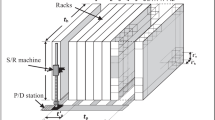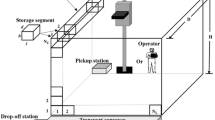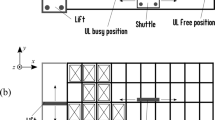Abstract
In this paper, closed-form travel-time expressions for flow-rack automated storage and retrieval systems are developed. The expressions, which are based on a continuous approach, are compared for accuracy, via simulation, with exact models which are based on a discrete approach.
There is no significant difference between the results obtained from the continuous-approach-based closed-form expressions and the ones from the discrete-approach-based exact solutions. The closed-form expressions are easy to calculate due to their simplistic forms, even without a computer, while the exact solutions are extremely complex. On the basis of computation time, the proposed closed-form expressions are extremely practical when compared with the discrete-approach-based expressions, which require extensive computation time.
The closed-form travel-time expressions developed in this study can be used to (1) establish performance standards for existing AS/RS, (2) evaluate throughput performance for flow-rack AS/RS alternative design configurations, and (3) compare different storage techniques for improved system performance. Due to their simplistic, yet accurate, definitions, the closed-form expressions, as well as the results of this study, are applicable to industry.
Similar content being viewed by others
References
Lee HF (1997) Performance analysis for automated storage and retrieval systems. IIE Trans 29(1):15–28
Allen SL (1992) A selection guide to AS/R systems. Ind Eng 24(1):28–31
Material Handling Institute (1997) Considerations for planning and installing an automated storage/retrieval system. AS/RS Document-100 7M
Barrett BG (1977) An empirical comparison of high-rise warehouse policies for operator-controlled stacker cranes. Logistics Research and Analysis, Eastman Kodak Company, Rochester, NY
Sand GM (1976) Stacker crane product handling systems. Eastman Kodak Company, Rochester, NY
Schwarz LB, Graves SC, Hausman WH (1978) Scheduling policies for automatic warehousing systems: simulation results. AIIE Trans 10(1):260–270
Koenig J (1980) Design and model the total system. Ind Eng 12(10):22–27
Bozer YA, White JA (1980) Optimum designs of automated storage/retrieval systems. In: Proceedings of the TIMS/ORSA joint national meeting, Washington, DC, May 1980
Zollinger HA (1975) Planning, evaluating and estimating storage systems. In: Proceedings of the seminar on advanced material handling, Purdue University, West Lafayette, IN, 29–30 April 1975
Karaswa Y, Nakayama H, Dohi S (1980) Trade-off analysis for optimal design automated warehouses. Int J Sys Sci 11(3):567–576
Bozer YA, White JA (1984) Travel-time models for automated storage/retrieval systems. IIE Trans 16(2):329–338
Egbelu PJ (1991) Framework for dynamic positioning of storage/retrieval machines in an automated storage/retrieval system, Int J Prod Res 29(1):17–37
Hwang H, Lim JM (1993) Deriving an optimal dwell point of the storage/retrieval machine in an automated storage/retrieval system. Int J Prod Res 31(8):2591–2602
Egbelu PJ, Wu CT (1993) A comparison of dwell point rules in automated storage/retrieval systems. Int J Prod Res 31(8):2515–2530
Peters BA, Smith JS, Hale TS (1996) Closed form models for determining the optimal dwell point location in automated storage and retrieval systems. Int J Prod Res 34(4):1757–1771
Chang SH, Egbelu PJ (1997) Relative pre-positioning of storage/retrieval machines in automated storage/retrieval systems to minimize maximum system response time. IIE Trans 29(2):303–312
Chang SH, Egbelu PJ (1997) Relative pre-positioning of storage/retrieval machines in automated storage/retrieval systems to minimize expected system response time. IIE Trans 29(2):313–322
Hausman WH, Schwarz LB, Graves SC (1976) Optimal storage assignment in automatic warehousing systems. Manage Sci 22(4):629–638
Graves SC, Hausman WH, Schwarz LB (1977) Storage retrieval interleaving in automatic warehousing systems. Manage Sci 23(7):935–945
Hwang H, Lee SB (1990) Travel-time models considering the operating characteristics of the storage and retrieval machine. Int J Prod Res 28(10):1779–1789
Chang DT, Wen UP, Lin JT (1995) The impact of acceleration/deceleration on travel-time models for automated storage retrieval systems. IIE Trans 27(1):108–111
Chang DT, Wen UP (1997) The impact on rack configuration on the speed profile of the storage and retrieval machine. IIE Trans 29(3):525–531
White JA, Kinney HD (1982) Storage and warehousing. In: Salvendy G (ed) Handbook of industrial engineering. Wiley, New York
Groover MP (1987) Automation production systems and computer integrated manufacturing. Prentice-Hall, Englewood Cliffs, NJ, pp 404–416
Author information
Authors and Affiliations
Corresponding author
Rights and permissions
About this article
Cite this article
Sari, Z., Saygin, C. & Ghouali, N. Travel-time models for flow-rack automated storage and retrieval systems. Int J Adv Manuf Technol 25, 979–987 (2005). https://doi.org/10.1007/s00170-003-1932-3
Received:
Accepted:
Published:
Issue Date:
DOI: https://doi.org/10.1007/s00170-003-1932-3




